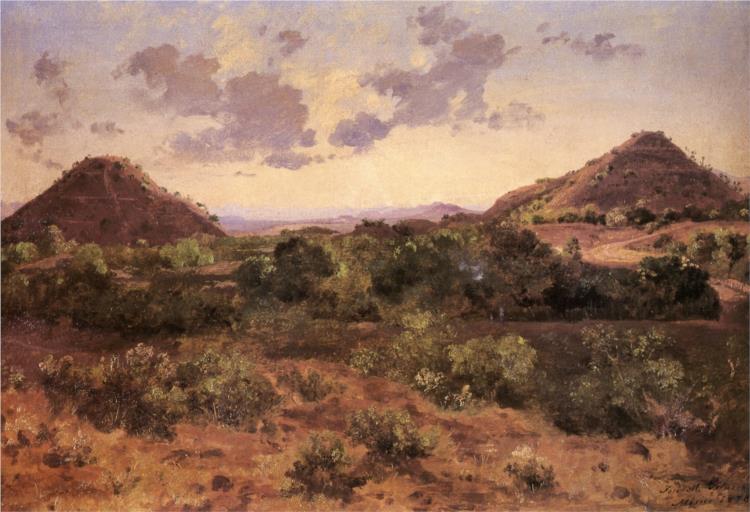Description
The work "Pyramids of the Sun and the Moon" (1878) by José María Velasco is a sublime testimony of the artist's ability to capture the majesty of the Mexican landscape through an intimate and careful look. To fully appreciate this work, it is essential to understand the artistic context and the evolution of the pictorial terrain in which Velasco was inserted. Born in 1840, this painter stood out as one of the greatest exponents of landscaping in Mexico and his work reflects a clear influence of romanticism, as well as a deep interest in the geographical and cultural reality of his country.
The composition of "Pyramids of the Sun and the Moon" shows a monumental representation of the famous pyramids of Teotihuacán, located a few kilometers northeast of Mexico City. In the work, the pyramids are erected with an almost religious presence, under a vast and bright sky that occupies a large part of the canvas. The use of space in the work is masterful; The immensity of the landscape highlights the greatness of these structures, while the warm and nuance colors add depth and a feeling of timelessness. The color palette is made up of terrible, ocher and gold tones that evoke the living history of the earth. This chromatic approach, along with an almost photographic elaboration of the details, allows the viewer to feel an intimate connection with the landscape.
It is worth highlighting the absence of human figures in this painting, which allows the focus to recay in the majesty of the natural and architectural environment. Through this choice, Velasco invites the viewer to reflect on the greatness of the ancient civilizations that these pyramids built and their relationship with the surrounding landscape, thus creating a dialogue between the past and the present. However, it cannot be affirmed that this absence is empty; On the contrary, it suggests a harmony and reverence towards the divine and the eternal that the pyramids represent.
Velasco's landscape style finds its maximum expression in "Pyramids of the Sun and the Moon" through the use of detailed realism that is often combined with an idealization of the landscape. Its painting technique allows each shadow and every ray of light to play a fundamental role in the construction of the atmosphere of the work, contributing to it a subtle dynamism that invites the viewer to explore every corner of the canvas. This approach can be seen in other works of Velasco, where he often captures the different facets of Mexican nature, from its mountains to its arid landscapes.
Through his work, José María Velasco not only became a visual chronicler of the Mexican landscape, but also encouraged a new appreciation of the country's cultural heritage. "Pyramids of the Sun and the Moon" is erected, therefore, not only as a representation of one of the wonders of the pre -Hispanic world, but also as a work that encapsulates the essence of Mexican national identity. The work is a reminder of the interconnection between culture, history and nature, an issue that continues to resonate in contemporary visual narrative. In this sense, Velasco painting not only invites us to admire a landscape, but to consider the stories and legacies that this same landscape has witnessed over time. In addition, their specificity and detail continue to inspire generations of artists and critics, reaffirming their place in the history of art and cultural memory of Mexico.
KUADROS ©, a famous paint on your wall.
Hand-made oil painting reproductions, with the quality of professional artists and the distinctive seal of KUADROS ©.
Art reproduction service with satisfaction guarantee. If you are not completely satisfied with the replica of your painting, we refund your money 100%.

